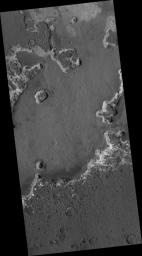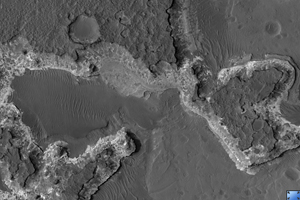
|
Layered Deposits in Ritchey Crater
- Click the image above for a larger view
- Full-Res JPEG (2048 x 3696) (708.4 kB)
- Full-Res TIFF (2048 x 3696) (7.6 MB)
Caption:

Click on image for larger version
HiRISE image ( PSP_003249_1510 ) shows eroding layered deposits in Ritchey Crater, a large impact crater in the southern highlands.
Three general units can be seen: a relatively dark upper layer, a light middle unit, and the floor material, which may be mostly obscured by dust. The dark cap layer appears to be relatively hard and resistant, while the light material is weak. Once the upper layer is removed, the light layer does not last long.
The cutout from the top center part of the image shows this stack. The dark unit is thin and breaking into boulders. The light material is actually divided into smaller layers, and is pervasively fractured. However, the boulders falling from the edge are mostly small and rarely remain intact if they move more than a few meters. The cracking of the layer could be due to water loss from the layer, or to regional tectonic effects such as stresses from burial and erosion. The base unit is partially covered by wind-blown ripples.
It is unclear how each of these layers formed. Volcanic ash layers, lake or stream deposits, or sandstone deposited by dunes can all produce horizontal layers. Unraveling the origin would provide important clues to Mars' past.
Observation Toolbox
Acquisition date:
4 April 2007
Local Mars time:
3:40 PM
Degrees latitude (centered):
-28.5°
Degrees longitude (East):
309.4°
Range to target site:
259.1 km (161.9 miles)
Original image scale range:
25.9 cm/pixel (with 1 x 1 binning) so objects ~78 cm across are resolved
Map-projected scale:
25 cm/pixel and north is up
Map-projection:
EQUIRECTANGULAR
Emission angle:
7.4°
Phase angle:
60.4°
Solar incidence angle:
53°, with the Sun about 37° above the horizon
Solar longitude:
214.1°, Northern Autumn
Background Info:
NASA's Jet Propulsion Laboratory, a division of the California Institute of Technology in Pasadena, manages the Mars Reconnaissance Orbiter for NASA's Science Mission Directorate, Washington. Lockheed Martin Space Systems, Denver, is the prime contractor for the project and built the spacecraft. The High Resolution Imaging Science Experiment is operated by the University of Arizona, Tucson, and the instrument was built by Ball Aerospace and Technology Corp., Boulder, Colo.
Cataloging Keywords:
| Name | Value | Additional Values |
|---|---|---|
| Target | Mars | |
| System | ||
| Target Type | Planet | |
| Mission | Mars Reconnaissance Orbiter (MRO) | |
| Instrument Host | Mars Reconnaissance Orbiter | |
| Host Type | Orbiter | |
| Instrument | High Resolution Imaging Science Experiment (HiRISE) | |
| Detector | ||
| Extra Keywords | Crater, Dune, Dust, Grayscale, Impact, Infrared, Map, Volcano, Water | |
| Acquisition Date | ||
| Release Date | 2007-04-25 | |
| Date in Caption | 2007-04-04 | |
| Image Credit | NASA/JPL/Univ. of Arizona | |
| Source | photojournal.jpl.nasa.gov/catalog/PIA09667 | |
| Identifier | PIA09667 | |
